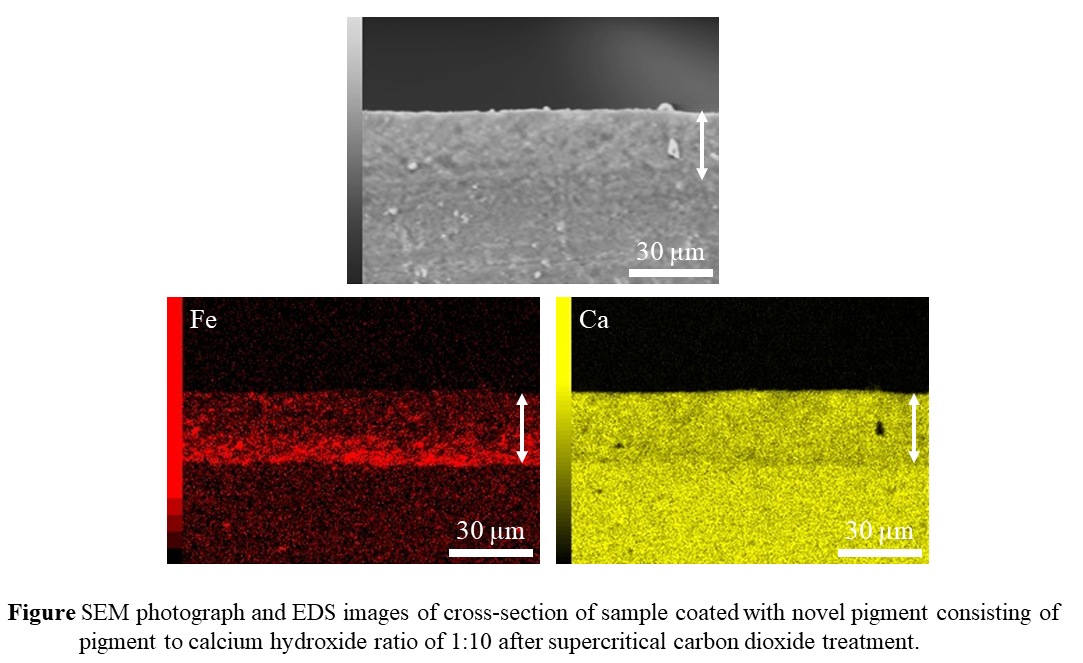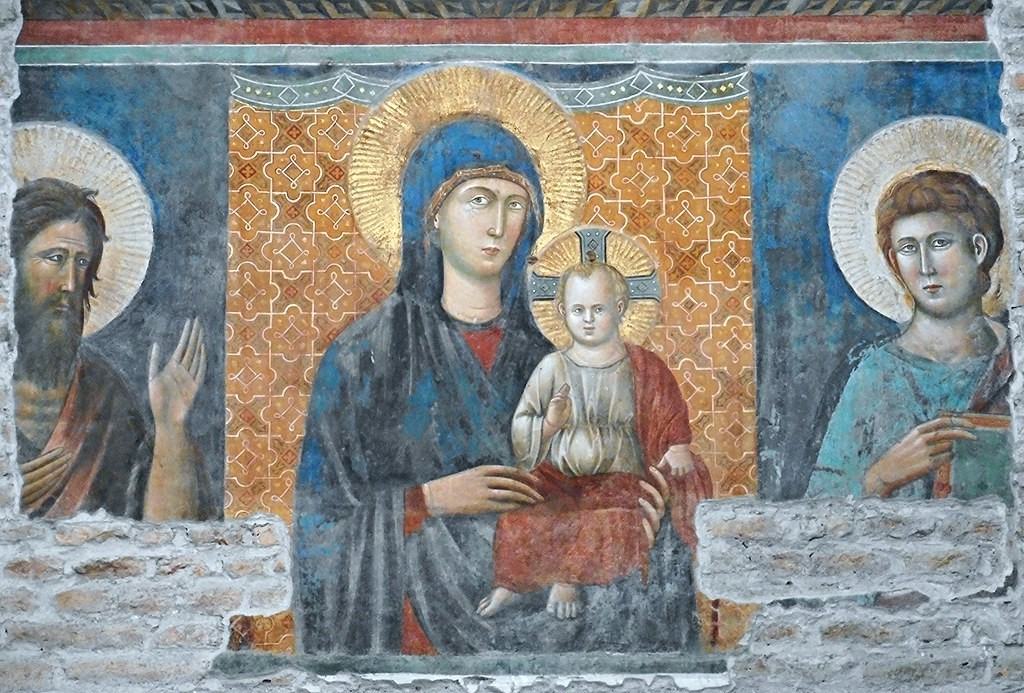FEATURE STORY - Frescoes, in a Flash: Nagoya Institute of Technology Researchers Create Frescoes in a Single Day
Category:News|Publishing : January 30, 2023
In medieval Europe, before the rise of oil paintings, fresco was a popular religious painting technique. Many artworks across Europe, hundreds of years old, utilize this method and constitute an important part of cultural heritage. Michelangelo's famous Sistine Chapel ceiling and Fra Angelo's Annunciation in Italy are perhaps two of the most well-known examples of frescoes. But how exactly does the fresco technique work?
A fresco is painted on a wet slaked lime plaster wall with natural rock pigments. The plaster, consisting of calcium hydroxide, reacts with water vapor and carbon dioxide in the atmosphere to form calcium carbonate. It gradually forms a protective coating over the pigments, preserving the painting. In addition, it increases the mechanical strength of the plaster. However, this process takes place over decades, making frescoes a rarely practiced art form.
In this regard, a group of researchers from the Department of Life Science and Applied Chemistry at the Nagoya Institute of Technology in Japan, including Professor Shinobu Hashimoto, Mr. Keitaro Yamaguchi, and Prof. Yuji Iwamoto, rapidly fabricated frescoes through a ceramic cold sintering technique that was "geomimetic", or inspired by the natural rock formation processes taking place in the Earth's crust.
The team's work was made available online on 4th November 2021 and published in Volume 48, Issue 4 of Ceramics International on 15th February 2022.
Prof. Hashimoto explains the idea behind geomimetic ceramics. "This hardening method is named so because it imitates the formation of sedimentary rocks in the crust. It employs a warm press to heat calcium hydroxide powder up to 300 °C under the high pressure of several hundred megapascals. These conditions harden the powder, forming the base material for frescoes."
The researchers painted on the fabricated bases using red iron oxide pigment powder because of its low environmental impact. Next, they performed supercritical carbon dioxide treatment. Supercritical carbon dioxide is a fluid form of carbon dioxide that forms when it is heated and held at a very high temperature and pressure. The application of supercritical carbon dioxide in their technique helped form calcium carbonate on the painted surface.
To ensure that the pigment stayed immobilized on the surface, the researchers subjected the painting to a warm press before the carbon dioxide treatment. The resultant calcium hydroxide layer exhibited superior visible light transmittance and better pigment immobilization.
Further, to ensure an even coating and sufficient translucency, the researchers mixed the pigment and calcium hydroxide powders for painting instead of powder coating the fresco. The heavier iron-based pigment particles in the mixture settled and deposited on the base, while the calcium hydroxide remained on top and covered the surface uniformly, ultimately resulting in an even calcium carbonate coating.
The researchers found that a 1:10 pigment-to-hydroxide ratio by mass was sufficient to immobilize the pigment particles. Adding more hydroxide made the painting whitish. They analyzed the structural characteristics of the resultant frescoes using scanning electron microscopy and energy dispersive x-ray spectroscopy to confirm the calcium and iron element distribution.
Lastly, the researchers measured pigment color differences among various mixing ratios with a colorimeter. The 1:10 novel mixture ratio showed appreciable color development. In fact, its pigment color was brighter than even the original pure pigment. The researchers suggest that the calcium hydroxide particles dispersed the red iron oxide pigments, reducing their aggregate size. That, in turn, increased the transmitted light intensity.
The results highlighted in this work will enable the rapid production of frescoes designed with calcium hydroxide mixed pigments, warm pressing, and supercritical carbon dioxide treatment. This fresco technique can also be used for the production of pigmented pictures on pottery, which could act as a push towards new, energy-efficient, unfired pottery technology.
Prof. Hashimoto puts into perspective the enormity of the present work. "Using our technique, a fresco, a historical art painting that takes hundreds of years to form, was successfully created in one day. This finding could facilitate unfired pottery technology for a low-energy society. It is important to pay attention to traditional fields as past technologies can also contribute to the latest advancements."
The new technique will certainly bring a breath of fresh air into the time-honored art of fresco painting!

Cross-section of base material coated with novel pigment mixture followed by supercritical carbon dioxide treatment
Scanning Electron Microscopy (gray) and Energy Dispersive X-Ray Spectroscopy (yellow and red) images reveal the calcium and iron elemental distribution in novel pigment mixture consisting of iron (red) oxide to calcium (yellow) hydroxide ratio of 1:10 by mass.
Image credit: Shinobu Hashimoto of the Nagoya Institute of Technology
License Type: Original Content

Researchers from Nagoya Institute of Technology develop a process to create a fresco in a single day
A research team from Japan have successfully created a fresco in a single day using a novel technique that mimics the formation of sedimentary rocks in the Earth's crust. Their method greatly hastens the completion of a fresco painting, which otherwise takes several decades to form.
Image credit: Carlo Raso from Openverse
(Link to image1: https://wordpress.org/openverse/image/fd32b343-0bbc-4c4a-9f73-e9b3459a91ec)
(Link to image2: https://www.flickr.com/photos/70125105@N06/25705666064)
License type: Public Domain
Reference
|
Title of original paper |
Rapid fabrication of frescoes using a geomimetic ceramic formation process |
|
Journal |
Ceramics International |
|
DOI |
|
|
Author(s) name |
Keitaro Yamaguchi, Shinobu Hashimoto, Yohei Nagata, Arisa Mori, Yuji Iwamoto |
|
Latest Article Publication Date |
February 15, 2022 |
About Professor Shinobu Hashimoto from Nagoya Institute of Technology, Japan
Shinobu Hashimoto is a Professor and Research Faculty at the Department of Life Science and Applied Chemistry at NITech. He obtained his bachelors, masters, and doctoral degrees from the Faculty of Engineering at Nagoya Institute of Technology. Prof. Hashimoto has authored over 140 publications with 1190 citations and an H-index of 17. His fields of expertise include inorganic, composite materials, and their surface and interface engineering. Prof. Hashimoto and his team are currently working on mineralogy, understanding crystal structure, and developing advanced ceramic fabrication methods.
Contact
Professor Shinobu Hashimoto
E-mail : hashimoto.shinobu[at]nitech.ac.jp
E-mail : +81-52-735-5291
Links : Details of a Researcher - HASHIMOTO Shinobu
*Please replace [at] with @ when contacting.
RESEARCH NEWS - Towards a New Antenna Paradigm with Waveform-Selective Metasurfaces PRESS RELEASE - DOCOMO, Keio University and Nagoya Institute of Technology Announce World's First Technology that Utilizes Human-Augmentation Platform for Sharing Haptic Information Between People

 Japanese
Japanese